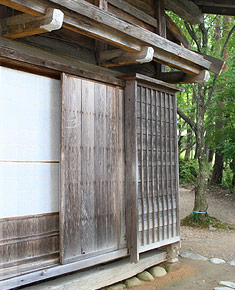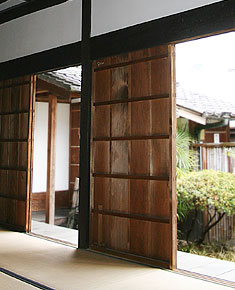1@Wooden
shutters constructed at the various openings of a building. They slide out
from a special storage box attached to the wall of the building. When not
needed, they are slid back into the storage box. The shutter positioned
at the farthest point away from the storage box is moved out first along
a single track; each shutter follows the previous one and is pushed until
it meets one already in place. Many shutters have mortises *hozoana
ΩΌ, on the edge of one side and tenons *hozo
ΩΌ, on the adjoining side for assuring a close fit. They also may have a
tongue and groove, sanehagi ΐ, for the same purpose. When all are
in place, they are secured by special wooden bolts otoshizaru ΅
(see *saru ), that drop
into the sills and/or by vertical wooden bolts agezaru γ° that are
pushed up into holes in the lintel *kamoi
. A sliding horizontal wooden catch holds the agezaru in place.
Amado are used at night to enclose the building and ensure its security
from thieves. They also protect the interior from wind, rain or snow. Amado
vary in style and size. Some have small sliding panels that can be opened
for ventilation in old traditional houses. It is said that amado
first appeared around the latter part of the 16c. They are found on temple
buildings, jiin @, some shrine buildings *jinja
_Π, varnacular dwellings *minka
―Ζ, and mansions, yashiki @.
2@Theaters built in the Edo period had amado positioned
on the upper story behind the audience's gallery sajiki V~. They
were closed in order to darken the interior during a performance. |




